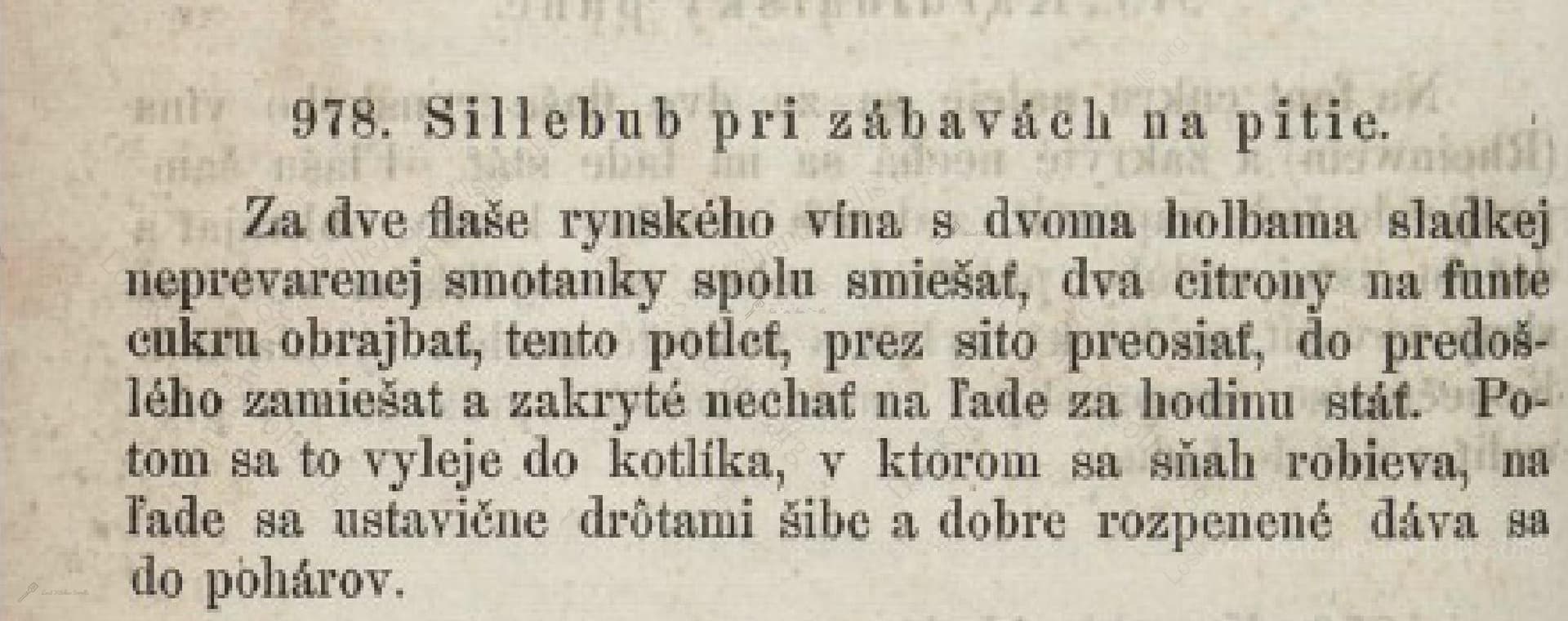Sillebub Pri Zábavách Na Pitie
"Syllabub For Parties To Drink"
From the treasured pages of Prvá kucharská kniha v slovenskej reči
Unknown Author

Sillebub Pri Zábavách Na Pitie
"Za dve flaše rynského vína s dvoma holbama sladkej neprevarenej smotanky spolu smiešať, dva citrony na funte cukru obrajbať, tento potleť, prez sito preosiat, do predoš-lého zamiešať a zakryté nechať na ľade za hodinu stáť. Po-tom sa to vyleje do kotlíka, v ktorom sa sňah robieva, na ľade sa ustavične drôtami šibe a dobre rozpenené dáva sa do pohárov."
English Translation
"For two bottles of Rhine wine, mix together with two mugs of sweet unboiled cream, grate the zest of two lemons over a pound of sugar, crush this, sift it through a sieve, and mix it into the previous mixture. Cover and let it stand on ice for an hour. Then pour it into a bowl in which egg whites are usually beaten, and continuously whip it on ice until foamy, then serve well-frothed in glasses."
Note on the Original Text
The recipe is written in a fluid, almost conversational manner, typical of 19th-century culinary texts, with approximate measurements and assumptions about the cook's practical knowledge. Ingredient quantities like ‘flaše’ (bottles) and ‘holby’ (tankards) are period-specific and require interpretation into modern metric measurements. Spelling and phrasing are characteristic of the Slovak language as used in the 1800s, including some Germanic borrowings and now-obsolete culinary terms. The instructions focus chiefly on sequence and desired texture (light, airy, foamy), rather than precise times or techniques, assuming familiarity with kitchen routines of the era.

Title
Prvá kucharská kniha v slovenskej reči (1870)
You can also click the book image above to peruse the original tome
Writer
Unknown
Era
1870
Publisher
Unknown
Background
An enchanting culinary treasure from the 19th century, this Slovak cookery book serves up a delightful array of recipes (recepty) to tempt the palate and inspire home chefs. A flavorful journey through time, it captures traditional tastes and kitchen wisdom with old-world charm.
Kindly made available by
Internet Archive
This recipe is drawn from an 1870 Slovak-language cookbook, offering us a glimpse into the lively world of Austro-Hungarian social gatherings. The 'Sillebub' (or Syllabub) was a popular, lightly alcoholic creamy punch, often served during festive drinking parties. Such recipes reflected refined European tastes of the time, blending imported wines and luxury dairy, and were associated with both celebratory occasions and genteel society. Published in the 19th century, this cookbook forms part of a cultural movement to document and standardize regional cuisines—here, merging Central European culinary traditions with influences from Western Europe.

In the original setting, this recipe would have been made using glass or ceramic bottles for ingredients, a sharp knife and coarse grater for preparing the lemon, and a fine mesh or cloth sieve for straining the citrus-sugar mixture. The final preparation relied on a large mixing bowl—often copper for its efficiency in aerating—and robust wire whisks. Chilling and whipping would have been done over chipped river ice or ice blocks stored in larders, rather than modern refrigeration.
Prep Time
1 hr 20 mins
Cook Time
0 mins
Servings
12
We've done our best to adapt this historical recipe for modern kitchens, but some details may still need refinement. We warmly welcome feedback from fellow cooks and culinary historians — your insights support the entire community!
Ingredients
- 6 1/3 cups (1.6 quarts) dry Rhine white wine (e.g., Riesling)
- 4 1/4 cups (1 quart plus 1 cup) fresh heavy cream (unboiled; 30-40% fat)
- 2 lemons (zest and juice)
- 2 1/4 cups (16 ounces) granulated sugar
Instructions
- To recreate this delightful 19th-century party Sillebub, start by mixing together 6 1/3 cups (or 1.6 quarts) of dry Rhine white wine (such as a modern Riesling) with 4 1/4 cups (or 1 quart plus 1 cup) of fresh, heavy cream that has not been previously boiled.
- Prepare the citrus by zesting and juicing 2 lemons over 2 1/4 cups (about 16 ounces) of granulated sugar.
- Allow the mixture of lemons and sugar to sit together, then pass it through a fine sieve to remove solids.
- Stir the fragrant lemon-sugar mixture into the wine and cream blend.
- Cover the mixture and chill it on ice or in the refrigerator for about one hour.
- After chilling, pour the mixture into a large bowl (ideally a copper or metal bowl as for whipping egg whites) and use a whisk to beat it vigorously over ice until it becomes foamy.
- Once well aerated, serve the Sillebub generously in glasses.
Estimated Calories
400 per serving
Cooking Estimates
You will need about 20 minutes to zest, juice, and mix the ingredients, plus about 1 hour for chilling before you whip the Sillebub. The total serving size gives about 12 generous glasses, and each has approximately 400 calories based on the wine, cream, sugar, and lemon used.
As noted above, we have made our best effort to translate and adapt this historical recipe for modern kitchens, taking into account ingredients nowadays, cooking techniques, measurements, and so on. However, historical recipes often contain assumptions that require interpretation.
We'd love for anyone to help improve these adaptations. Community contributions are highly welcome. If you have suggestions, corrections, or cooking tips based on your experience with this recipe, please share them below.
Join the Discussion
Rate This Recipe
Dietary Preference
Culinary Technique

Den Bockfisch In Einer Fleisch Suppen Zu Kochen
This recipe hails from a German manuscript cookbook compiled in 1696, a time whe...

Die Grieß Nudlen Zumachen
This recipe comes from a rather mysterious manuscript cookbook, penned anonymous...

Ein Boudain
This recipe comes from an anonymous German-language manuscript cookbook from 169...

Ein Gesaltzen Citroni
This recipe, dating from 1696, comes from an extensive anonymous German cookbook...
Browse our complete collection of time-honored recipes



